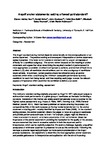Angoff anchor statements: setting a flawed gold standard?
| dc.contributor.author | Burr, Steven | |
| dc.contributor.author | Zahra, Daniel | |
| dc.contributor.author | Cookson, J | |
| dc.contributor.author | Hagen, Chris | |
| dc.contributor.author | Gabe-Thomas, Elizabeth | |
| dc.contributor.author | Robinson, Iain | |
| dc.date.accessioned | 2017-11-30T12:41:29Z | |
| dc.date.available | 2017-11-30T12:41:29Z | |
| dc.date.issued | 2017-09-21 | |
| dc.identifier.issn | 2312-7996 | |
| dc.identifier.issn | 2312-7996 | |
| dc.identifier.uri | http://hdl.handle.net/10026.1/10351 | |
| dc.description | http://www.mededpublish.org/manuscripts/1201 | |
| dc.description.abstract |
<ns3:p>This article was migrated. The article was marked as recommended. The Angoff standard setting method depends fundamentally on the conceptualisation of an anchor statement. The precise wording and consequent interpretation of anchor statements varies in practice. Emphasis is often placed on standard setting judges' perceptions of difficulty for a candidate subgroup. The current review focusses on the meaning of anchor statements and argues that when determining the required standard of performance it is more appropriate to consider: (1) what it is important to achieve, and not how difficult it is to achieve it; (2) what all candidates should achieve, and not what a subgroup of candidates would achieve. In summary, current practice should be refined by using an anchor statement which refers to estimating the 'minimum acceptable performance by every candidate' for each item being tested, and then requiring each judge to score the relevant aspects of importance which could then be combined to derive a cut-score.</ns3:p> | |
| dc.format.extent | 1-7 | |
| dc.language | en | |
| dc.language.iso | en | |
| dc.publisher | F1000 Research Ltd | |
| dc.subject | Rare Diseases | |
| dc.title | Angoff anchor statements: setting a flawed gold standard? | |
| dc.type | journal-article | |
| plymouth.issue | 3:53 | |
| plymouth.volume | 6 | |
| plymouth.publication-status | Published online | |
| plymouth.journal | MedEdPublish | |
| dc.identifier.doi | 10.15694/mep.2017.000167 | |
| plymouth.organisational-group | /Plymouth | |
| plymouth.organisational-group | /Plymouth/Faculty of Health | |
| plymouth.organisational-group | /Plymouth/Faculty of Health/Peninsula Dental School | |
| plymouth.organisational-group | /Plymouth/Faculty of Health/Peninsula Medical School | |
| plymouth.organisational-group | /Plymouth/REF 2021 Researchers by UoA | |
| plymouth.organisational-group | /Plymouth/REF 2021 Researchers by UoA/UoA03 Allied Health Professions, Dentistry, Nursing and Pharmacy | |
| plymouth.organisational-group | /Plymouth/Research Groups | |
| plymouth.organisational-group | /Plymouth/Research Groups/Institute of Translational and Stratified Medicine (ITSMED) | |
| plymouth.organisational-group | /Plymouth/Research Groups/Institute of Translational and Stratified Medicine (ITSMED)/CBR | |
| plymouth.organisational-group | /Plymouth/Research Groups/Plymouth Institute of Health and Care Research (PIHR) | |
| plymouth.organisational-group | /Plymouth/Users by role | |
| plymouth.organisational-group | /Plymouth/Users by role/Academics | |
| dcterms.dateAccepted | 2017-09-21 | |
| dc.identifier.eissn | 2312-7996 | |
| dc.rights.embargoperiod | Not known | |
| rioxxterms.versionofrecord | 10.15694/mep.2017.000167 | |
| rioxxterms.licenseref.uri | http://www.rioxx.net/licenses/all-rights-reserved | |
| rioxxterms.licenseref.startdate | 2017-09-21 | |
| rioxxterms.type | Journal Article/Review |


